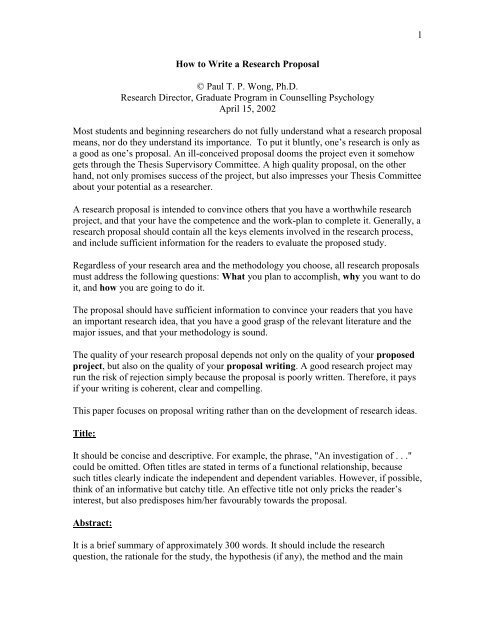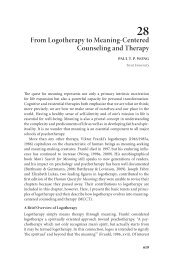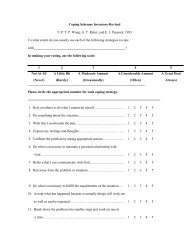How to Write a Research Proposal - DrPaulWong.com
How to Write a Research Proposal - DrPaulWong.com
How to Write a Research Proposal - DrPaulWong.com
You also want an ePaper? Increase the reach of your titles
YUMPU automatically turns print PDFs into web optimized ePapers that Google loves.
1<br />
<strong>How</strong> <strong>to</strong> <strong>Write</strong> a <strong>Research</strong> <strong>Proposal</strong><br />
© Paul T. P. Wong, Ph.D.<br />
<strong>Research</strong> Direc<strong>to</strong>r, Graduate Program in Counselling Psychology<br />
April 15, 2002<br />
Most students and beginning researchers do not fully understand what a research proposal<br />
means, nor do they understand its importance. To put it bluntly, one’s research is only as<br />
a good as one’s proposal. An ill-conceived proposal dooms the project even it somehow<br />
gets through the Thesis Supervisory Committee. A high quality proposal, on the other<br />
hand, not only promises success of the project, but also impresses your Thesis Committee<br />
about your potential as a researcher.<br />
A research proposal is intended <strong>to</strong> convince others that you have a worthwhile research<br />
project, and that your have the <strong>com</strong>petence and the work-plan <strong>to</strong> <strong>com</strong>plete it. Generally, a<br />
research proposal should contain all the keys elements involved in the research process,<br />
and include sufficient information for the readers <strong>to</strong> evaluate the proposed study.<br />
Regardless of your research area and the methodology you choose, all research proposals<br />
must address the following questions: What you plan <strong>to</strong> ac<strong>com</strong>plish, why you want <strong>to</strong> do<br />
it, and how you are going <strong>to</strong> do it.<br />
The proposal should have sufficient information <strong>to</strong> convince your readers that you have<br />
an important research idea, that you have a good grasp of the relevant literature and the<br />
major issues, and that your methodology is sound.<br />
The quality of your research proposal depends not only on the quality of your proposed<br />
project, but also on the quality of your proposal writing. A good research project may<br />
run the risk of rejection simply because the proposal is poorly written. Therefore, it pays<br />
if your writing is coherent, clear and <strong>com</strong>pelling.<br />
This paper focuses on proposal writing rather than on the development of research ideas.<br />
Title:<br />
It should be concise and descriptive. For example, the phrase, "An investigation of . . ."<br />
could be omitted. Often titles are stated in terms of a functional relationship, because<br />
such titles clearly indicate the independent and dependent variables. <strong>How</strong>ever, if possible,<br />
think of an informative but catchy title. An effective title not only pricks the reader’s<br />
interest, but also predisposes him/her favourably <strong>to</strong>wards the proposal.<br />
Abstract:<br />
It is a brief summary of approximately 300 words. It should include the research<br />
question, the rationale for the study, the hypothesis (if any), the method and the main
2<br />
findings. Descriptions of the method may include the design, procedures, the sample, and<br />
any instruments that will be used.<br />
Introduction:<br />
The main purpose of the introduction is <strong>to</strong> provide the necessary background or context<br />
for your research problem. <strong>How</strong> <strong>to</strong> frame the research problem is perhaps the biggest<br />
problem in proposal writing.<br />
If the research problem is framed in the context of a general, rambling literature review,<br />
then the research question may appear trivial and uninteresting. <strong>How</strong>ever, if the same<br />
question is placed in the context of a very focused and current research area, its<br />
significance will be<strong>com</strong>e evident.<br />
Unfortunately, there are no hard and fast rules on how <strong>to</strong> frame your research question<br />
just as there is no prescription on how <strong>to</strong> writing an interesting and informative opening<br />
paragraph. A lot depends on your creativity, your ability in clear thinking and the depth<br />
of your understanding of problem areas.<br />
<strong>How</strong>ever, try <strong>to</strong> place your research question in the context of either a current “hot” area,<br />
or an older area that remains viable. Secondly, you need <strong>to</strong> provide a brief but the most<br />
appropriate his<strong>to</strong>rical backdrop. Thirdly, provide the contemporary context in which your<br />
proposed research question occupies the central stage. Finally, identify “key players” and<br />
refer <strong>to</strong> the most relevant and representative publications. In short, try <strong>to</strong> paint your<br />
research question in broad brushes and at the same time bring out its significance.<br />
The introduction typically begins with a general statement of the problem area, with a<br />
focus on a specific research problem, <strong>to</strong> be followed by the rational or justification for<br />
the proposed study. The introduction generally covers the following elements:<br />
1. State the research problem, which is often referred <strong>to</strong> as the purpose of the<br />
study.<br />
2. Provide the context and set the stage for your research question in such a way as<br />
<strong>to</strong> show its necessity and importance.<br />
3. Present the rationale of your proposed study, and clearly indicate why it is worth<br />
doing.<br />
4. Briefly describe the major issues and sub-problems <strong>to</strong> be addressed by your<br />
research.<br />
5. Identify the key independent and dependent variables of your experiment.<br />
Alternatively, specify the phenomenon you want <strong>to</strong> study.<br />
6. State your hypothesis or theory, if any. For explora<strong>to</strong>ry or phenomenological<br />
research, you may not have any hypotheses. (Please do not confuse the<br />
hypothesis with the statistical null hypothesis.)<br />
7. Set the delimitation or boundaries of your proposed research in order <strong>to</strong> provide a<br />
clear focus.<br />
8. Provide definitions of key concepts. (This is optional.)
3<br />
Literature Review:<br />
Sometimes, the literature review is incorporated in the introduction section. <strong>How</strong>ever,<br />
most professors prefer a separate section, which allows a more thorough review of the<br />
literature.<br />
The literature review serves several important functions:<br />
1. Ensures that you are not “re-inventing the wheel”.<br />
2. Gives credits <strong>to</strong> those who have laid the groundwork for your research.<br />
3. Demonstrates your knowledge of the research problem.<br />
4. Demonstrates your understanding of the theoretical and research issues related <strong>to</strong><br />
your research question.<br />
5. Shows your ability <strong>to</strong> critically evaluate relevant literature information.<br />
6. Indicates your ability <strong>to</strong> integrate and synthesizes the existing literature.<br />
7. Provides new theoretical insights or develops a new model as the conceptual<br />
framework for your research.<br />
8. Convinces your reader that your proposed research will make a significant and<br />
substantial contribution <strong>to</strong> the literature (i.e., resolving an important theoretical<br />
issue or filling a major gap in the literature).<br />
Most of the literature reviews of students suffer from the following problems:<br />
<br />
<br />
<br />
<br />
<br />
<br />
<br />
<br />
Lacking organization and structure<br />
Lacking focus, unity and coherence<br />
Being repetitive and verbose<br />
Failing <strong>to</strong> cite influential papers<br />
Failing <strong>to</strong> keep up with recent developments<br />
Failing <strong>to</strong> critically evaluate cited papers<br />
Citing irrelevant or trivial references<br />
Depending <strong>to</strong>o much on secondary sources<br />
Your scholarship and research <strong>com</strong>petence will be questioned if any of the above applies<br />
<strong>to</strong> your proposal.<br />
There are different ways <strong>to</strong> organize your literature review. Make use of sub-headings <strong>to</strong><br />
bring order and coherence <strong>to</strong> your review. For example, having established the<br />
importance of your research area and its current state of development, you may devote<br />
several subsections on related issues as: theoretical models, measuring instruments,<br />
cross-cultural and gender differences, etc.<br />
Remember that your proposal attempts <strong>to</strong> present a case <strong>to</strong> justify your research.<br />
Therefore, your literature review should strengthen rather than weaken you case.
4<br />
It is also helpful <strong>to</strong> keep in mind that you are telling a s<strong>to</strong>ry <strong>to</strong> an audience. Try <strong>to</strong> tell it<br />
in a stimulating and engaging manner. Do not bore them, because it may lead <strong>to</strong> rejection<br />
of your worthy proposal. (Remember: Professors and scientists are human beings <strong>to</strong>o.)<br />
Methods:<br />
The Method section is very important, because it tells your <strong>Research</strong> Committee how you<br />
plan <strong>to</strong> tackle your research problem. It will provide your work plan and describe the<br />
activities necessary for the <strong>com</strong>pletion of your project.<br />
The guiding principle for writing the Method section is that it should contain sufficient<br />
information for the reader <strong>to</strong> determine whether methodology is sound. Some even argue<br />
that a good proposal should contain sufficient details for another qualified researcher <strong>to</strong><br />
implement the study.<br />
You need <strong>to</strong> demonstrate your knowledge of alternative methods and make the case that<br />
your approach is the most appropriate and most valid way <strong>to</strong> address your research<br />
question.<br />
Please note that your research question may be best answered by qualitative research.<br />
<strong>How</strong>ever, since most mainstream psychologists are still biased against qualitative<br />
research, especially the phenomenological variety, you may need <strong>to</strong> justify your<br />
qualitative method.<br />
Furthermore, since there are no well-established and widely accepted canons in<br />
qualitative analysis, your method section needs <strong>to</strong> be more elaborate than what is required<br />
for traditional quantitative research. More importantly, the data collection process in<br />
qualitative research has a far greater impact on the results as <strong>com</strong>pared <strong>to</strong> quantitative<br />
research. That is another reason for greater care in describing how you will collect and<br />
analyze your data. (<strong>How</strong> <strong>to</strong> write the Method section for qualitative research will be the<br />
<strong>to</strong>pic for another paper.)<br />
For quantitative studies, the method section typically consists of the following sections:<br />
1. Design –Is it a questionnaire study or a labora<strong>to</strong>ry experiment? What kind of<br />
design do you choose?<br />
2. Subjects or participants – Who will take part in your study? What kind of<br />
sampling procedure do you use?<br />
3. Instruments – What kind of measuring instruments or questionnaires do you<br />
use? Why do you choose them? Are they valid and reliable?<br />
4. Procedure – <strong>How</strong> do you plan <strong>to</strong> carry out your study? What activities are<br />
involved? <strong>How</strong> long does it take?
5<br />
Results<br />
Obviously, you do not have results at the proposal stage. <strong>How</strong>ever, you need <strong>to</strong> have<br />
some idea about what kind of data you will be collecting, and what statistical procedures<br />
will be used in order <strong>to</strong> answer your research question or test you hypothesis.<br />
Discussion:<br />
It is important that you need <strong>to</strong> convince your reader of the potential impact of your<br />
proposed research. You need <strong>to</strong> <strong>com</strong>municate a sense of enthusiasm and confidence<br />
without exaggerating the merits of your proposal. That is why you also need <strong>to</strong> mention<br />
the limitations and weaknesses of the proposed research, which may be justified by time<br />
and financial constraints as well as by the early developmental stage of your research<br />
area.<br />
Common Mistakes in <strong>Proposal</strong> Writing<br />
1. Failure <strong>to</strong> provide the proper context <strong>to</strong> frame the research question.<br />
2. Failure <strong>to</strong> delimit the boundary conditions for your research.<br />
3. Failure <strong>to</strong> cite landmark studies.<br />
4. Failure <strong>to</strong> accurately present the theoretical and empirical contributions by other<br />
researchers.<br />
5. Failure <strong>to</strong> stay focused on the research question.<br />
6. Failure <strong>to</strong> develop a coherent and persuasive argument for the proposed research.<br />
7. Too much detail on minor issues, but not enough detail on major issues.<br />
8. Too much rambling -- going "all over the map" without a clear sense of direction.<br />
(The best proposals move forward with ease and grace like a seamless river.)<br />
9. Too many citation lapses and incorrect references.<br />
10. Too long or <strong>to</strong>o short.<br />
11. Failing <strong>to</strong> follow the APA style.<br />
12. Sloppy writing.













